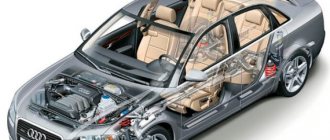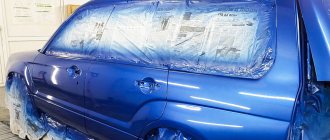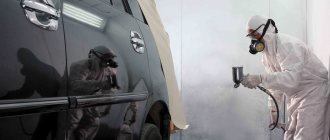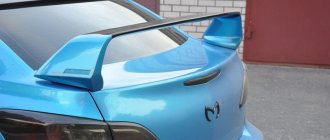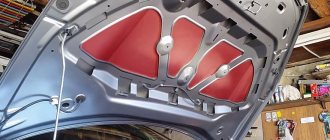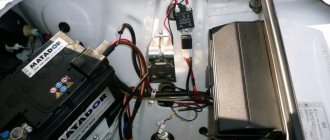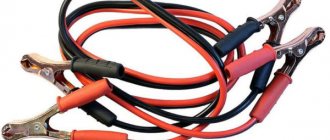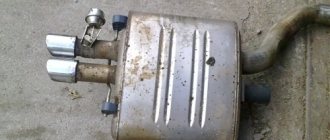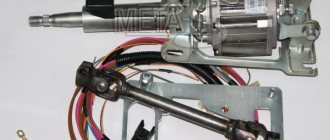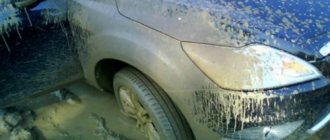Renewing paintwork is a service that is in great demand. Sometimes clients order repainting of the entire car, more often - painting of individual parts that have been in an accident (or new parts to replace damaged ones).
If a car is being painted in a room, it must be equipped with a powerful ventilation system. The owner of the box has 2 options: purchase a factory paint booth, which already has a built-in ventilation system, or organize the right conditions in an empty room.
Let's look at how to organize it correctly.
Preliminary advice : designing and installing ventilation equipment for painting booths is a responsible task. You cannot work without a ventilation system, even if you have a garage where you cheaply paint scratched fenders and doors for old domestic cars - because a violation of air exchange can lead to a fire or poisoning.
If we are talking about a “full-fledged” paint booth that is officially operating, the ventilation system for it must be designed by specialists. All information below is for informational purposes only.
Is it necessary to provide ventilation in the paint booth, and why?
Yes , definitely .
The ventilation system in paint booths performs the following functions:
- Cleans the incoming air from dust and dirt that can settle on the paintwork.
- Filters the exhaust air from harmful substances and odors. They also harm the environment and can be dangerous (and the smell is unpleasant) if the spray booth is located near people. For example, if you are painting a car in your garage, and there are garages of other car owners nearby. In this case, we are talking not only about the discomfort of neighbors, but also about violation of sanitary standards. If the maximum permissible concentration of harmful substances due to your work exceeds the norms, wait for the Sanitation Station.
- Removes harmful substances that are released during painting and can harm the painter. The most important factor, since paints and varnishes contain substances of hazard classes I and II (“extremely dangerous” and “highly dangerous”), including those that penetrate the body through the skin and digestive tract (from dirty hands).
- Removes vapors from explosive substances. Xylene is released from paintwork materials, and white spirit (a highly flammable substance) and solvents that contain it are also dangerous.
If there is insufficient air exchange, painting even one car can harm the health of the car painter. And if you decide to paint for a long time in a closed small garage, you can get acute poisoning from paint vapors.
Therefore, even if we are talking about repainting 1 spare part, sufficient air exchange must be provided for the work.
Security measures
The main purpose of installing a ventilation system is to ensure the safety of painters. When painting, a large number of particles of paint, solvent, and varnish enter the air. A toxic mist appears that causes discomfort to the mucous membranes during breathing. Proper ventilation should press the resulting “fog” to the floor with a vertical air pressure.
Employees must also use protective equipment:
- respirator;
- gloves;
- protective clothing;
- mask and glasses;
- closed shoes.
The room must be finished with fire-resistant materials; there should be no sources of open fire; The wiring is carefully insulated.
Cabinets, equipment, and any other items are removed from the spray booth so that dust does not accumulate on them and they do not interfere with ventilation.
General requirements for the ventilation system of a paint booth
Let's list the main rules:
- Ventilation should be only mechanical (forced).
- Filters must be installed on both the supply and exhaust.
- Ventilation equipment must be explosion-proof.
- Air is supplied through the ceiling, flowing vertically downwards. Exhaust hood - organized through floor gratings.
What is taken into account when designing? (+video with general information)
That's what:
- Car size. The size of the chamber itself depends on this - it should not be too large, since then a more powerful ventilation system will have to be made. The average size of cameras for passenger cars is 6.9x3.9x2.7.
- Type of paint (to know the composition of paintwork materials, type of solvents). Based on this, better filters can be selected.
- How often do you plan to paint, and how long will the work take?
What does the paint shop ventilation system consist of?
The ventilation system of a painting booth consists of an inflow (supply of fresh air) and an exhaust (removal of exhaust air).
Diagram of the ventilation system of the spray booth
The supply line includes:
- 1 radial fan in explosion-proof design.
- Stainless steel air duct running from the street to the space above the ceiling (air supply is from top to bottom).
- A filter built into the ceiling is used to clean the air from dust. There can be 2 inlet filters: the first for pre-cleaning, the second for fine cleaning.
- Heater: burner, heater + boiler, or heating element.
The exhaust line includes:
- 1 radial fan in explosion-proof design.
- Channels under the floor, covered with grating. They are located along the walls.
- Stainless steel duct running from under the floor to the street.
- Several filters. Usually they put 2: the first - immediately under the floor grille, the second - in front of the exhaust fan.
For control and measurements use:
- 2 dampers: on the exhaust and on the supply.
- Thermometer or room temperature sensor.
More information about ceiling filters (video)
More about the box (video)
Learn more about air flow and heating (video)
Calculation
Correct calculation is necessary to select the optimal parameters of the ventilation system. If the air supply is too intense, technological processes will be disrupted; if there is insufficient ventilation, painter operators are at risk.
To calculate the ventilation performance of a paint booth, you need to use the formula P=V×T×0.36, where T is the temperature difference between the supplied air and that required in the paint booth, V is the air volume in , and 0.36 is the expansion factor.
Knowing this parameter, it is easy to set the required air exchange mode. Calculation of optimal air exchange is carried out as follows: the volume of the working room is multiplied by the average rate of air movement.
Depending on the calculation results, you can understand which type of ventilation is suitable in a particular case. If all installation standards are followed, the spray booth will be as productive and safe as possible.
Calculation of equipment power and air exchange rate
There are 2 ways to calculate fan power:
- The average productivity of the system is 800 m³/h per 1 m² of area. That is, for a chamber 6x4 m² we get: 6 x 4 x 800 = 19200 m³/h.
- The air exchange rate is 300. That is, for a 6x4x3 chamber (volume - 72 m³) the air exchange should be 300 x 72 = 21600 m³/h.
Both fans (supply and exhaust) should have this power (or better yet, a little more).
As you can see, the calculation gives different results. It is better to use the second formula. The first one can be used if you plan to paint infrequently and for a short time.
Ventilation operating modes in painting booths
Using the correct technology, painting is carried out in 4 stages:
- Spraying is the application of paint to a part.
- Blowing - supplying air horizontally (from the side) to the part to level the paint layer.
- Drying.
- Cooling (necessary, since drying is carried out at a temperature of +60-80º).
Therefore, in automotive paint booths, the ventilation system must operate within the performance (air exchange) and temperature ranges that cover these 4 stages.
The most “demanding” temperature is the drying stage: it should be +60..+110º (more precisely, it depends on the paint).
Design stages
To understand the procedure for performing system design work, you should consider the main guarantee of high-quality painting - the presence of a productive air filtration system. To do this, you need to calculate the air performance of the box. To avoid unacceptable or at least severe working conditions, an air flow of about 25 cm/s should be provided at certain points in the chamber. The average value should be approximately 30 cm/s, more is possible.
Once the specialist obtains the average flow rate, he will be able to determine the volume of passage over one hour. Then it will become clear how many fans need to be installed, in what location and at what power. At the same time, the design of the spray booth includes filters and channels, and accordingly, air resistance will occur. Therefore, the power must have a reserve. Modern paint booths have supply and exhaust units, which means that an exhaust and supply fan must be included in the design of the booth.
Filters also need to be designed - not only their location, but also the area of the filters. For painting booths, a multi-stage system is used, that is, large and small fractions are removed. To determine the minimum area, the specialist takes the pre-calculated flow and divides it by the filter flow value. Filters also need to be used with reserve.
The situation is similar with floor filters. There are three standard layouts for floor elements. You can make a grille for the entire car, or you can install narrow grilles exclusively for the wheels. You can also make a floor completely covered with filters. But you also need to look at the budget allocated for the construction of the paint booth.
Important points
One of the special aspects is the development of lighting and fire safety systems. Lamps on the ceiling and walls are used for lighting. For more efficient application of paint to the work surface, you can install the device on the back wall of the work area. The illumination level of the box should be close to 2 thousand lux. Moreover, the lamps themselves should not have a flickering effect. It is popular to arrange devices vertically, but in a checkerboard pattern.
Fire safety requirements are very strict. All used elements of the box must be protected from a potential explosion. This also applies to the material in the walls of the box - mineral wool is suitable. The operation of a paint booth is impossible without a fire extinguishing system.
For a professional paint booth, it is beneficial for the design to be carried out by an organization that takes care of further maintenance of key components. The development of such premises should be carried out by people who have not only experience, but also special permission to work. For example, special approval is needed to install a gas burner in a paint booth.
Approximate cost of a ventilation system (design + equipment + installation)
Let's calculate the cost when arranging a room for painting:
| Expenditure | Cost, thousand rubles |
| Design taking into account lighting, ventilation, heating, filters | From 50-70 |
| Scroll fan in explosion-proof design, 18000 m³/h, 4 kW | 40 (we need 2 pieces, that means 80) |
| Heater (diesel or gas) 250 kW | From 75 |
| Air temperature sensor | 1 |
| Floor filter for paint retention (PS3), roll 0.75x20 m | 5 |
| Ceiling fine filter, class F5, roll 2x20 m | 15 |
| Carbon filter (for exhaust) | 12-15 |
| Differential pressure gauge (to monitor filter contamination) | 3-4 |
| A set of galvanized air ducts (with all bends, adapters, inserts), 30-40 m long (for supply and exhaust, with a reserve) | 75 |
| Ventilation control panel | 5-15 |
In total, it comes out to about 320 thousand rubles only for ventilation (that is, lighting, wall decoration, floor grilles, entry, gates - we pay separately). This does not include the services of specialists in installing and connecting this equipment. Of course, we calculated roughly rounded amounts, and in practice the price may be lower.
Approximate cost of a finished chamber with a ventilation system
Ready-made spray booths with ventilation (for 1 passenger car) cost approximately the following:
- Colortech CT 7000 (Türkiye): from 1.3 million rubles. Size - 7x4x2.8 m, burner 237 kW, supply and exhaust capacity - 18,000 m³/h.
- Colortech CT 6000 (Turkey): from 1.1 million. The characteristics are the same, only the size is different: 6.2x4.08x3.4 m.
- SK-1 Technosoyuz (RF): from 750 thousand. Size - 7.2x4.8x3.5 m, air capacity - 22000 m³/h, temperature control - from +20º to +90º.
- Guangli GL-2000A GL-3 (China): from 1 million. Size - 6.9x3.9x2.7 m, air capacity - 24,000 m³/h.
- Technoline Grand (China): from 800 thousand. Size - 6.9x4x2.9 m, air exchange - 26000 m³/h, 330 kW diesel burner.
- SPK-4.4.3 (RF): from 2.7 million. Size - 4x4x3 m, air exchange - 10,000 m³/h, for air heating - 282 kW heating element. There is a programmable controller with touch control.
- Atis Aqua Prima 7.5.4 (RF): from 900 thousand. Size - 6.9x3.9x2.7 m, air exchange - 24000 m³/h, diesel burner 218 kW.
- Nordberg Standard (China): from 975 thousand. Size - 6.9x3.9x2.7 m, air exchange - 80,000 m³/h, 202 kW diesel burner.
All models have filters (the set and their quality varies), built-in explosion-proof lamps, fire sensors, and ventilation control systems. The price does not include delivery and installation.
It turns out that for a conventional 1 million rubles you can get a ready-made chamber with ventilation, lighting, heating and filters. If you look at the cheapest models, or look for used ones, you can find equipment for 500-600 thousand.
Therefore, it is easier and faster to take a ready-made camera than to equip it from scratch. In terms of price, it will cost a little more or about the same as the arrangement. But in the end, you get a completely finished box that will allow you to correctly apply the painting technology, will not pollute the air with harmful emissions, and will not create a danger for the painter.
Presentation of the Blowtherm spray booth (video, not in Russian)
Types of ventilation systems
Ventilation in the painting booth can be single-engine, double-engine or supply and exhaust. In addition, there are rooms with passing air flow, with increased pressure and with vacuum.
In single-motor chambers, air enters the room from above, pressure is created in the working room and the colorful mist falls down and is discharged outside through specially designed holes in the floor. In dual-motor chambers, air also enters from above. Additionally, they are equipped with a lower motor that sucks air from the workroom to the street.
In such boxes, ventilation is more efficient, but from an economic point of view, using a dual-motor chamber is not always advisable. For example, for small volumes of painting work and small traffic flows, it may often be more profitable to install a single-engine camera. The supply and exhaust ventilation system of the spray booth operates in three main modes:
- Mode of active air circulation with continuous filtration, cleaning it from dust before starting work
- The mode of air intake from the outside with subsequent filtration, heating to 30 degrees, supply to the workspace and output to the outside without filtration through holes in the floor (i.e., a mode that maintains a constant temperature in the chamber during operation)
- Mode of pumping filtered air heated to 60 degrees from the chamber (i.e. drying products after painting)
Supply and exhaust ventilation is calculated in such a way that “dead zones” do not appear in the workroom, in which sufficient air circulation is not provided, and after spraying the paint, its fine dust is not discharged outside, but hangs in the air.
The most common are high-pressure chambers in which two fans operate - a pumping and a suction. At the same time, the productivity of the blower is greater, and the excess air resulting from the difference in fan productivity creates increased pressure in the chamber. External dust cannot enter the workspace due to the fact that it is displaced by air.
In the chambers with a passing air flow, two fans with the same performance are installed, as a result of which the pressure outside is equal to the internal pressure in the working room. Unlike a high-pressure box, such a chamber should be as sealed as possible to prevent dust from getting inside. And in rooms with rarefaction there are two fans with different capacities: the fan that sucks air from the chamber has a higher capacity.
Creating a ventilation system for a paint shop with your own hands in the garage (+ video)
If you decide to make a homemade painting box in the garage, let’s briefly look at the stages of work:
- Let's create a diagram. We “try on” where the inflow and exhaust points will be located, how the air ducts will pass.
- We drill holes in the walls (or ceiling) for the air ducts.
- Assembling the box frame.
- We lay air ducts, install a heater and supply and exhaust fans. They must be placed outside the box (possibly between the frame and the walls of the garage itself).
- We install an air distribution system with a filter on the ceiling.
- We cover the ceiling and frame with panels, install lighting.
- We make a recess in the floor to remove air. Or there is a simpler option, so as not to chisel the floor yourself: we order joists from steel pipes. It turns out that the car will not stand on the “original” floor, but on the joists mounted above it.
Chamber floor joists
- We lay the air duct to the underground space.
- We place a filter under the joists to hold the paint, and put a grate on top.
Done - you have a homemade box made with your own hands.
Advice for those who decide to do it themselves: find a ventilation specialist who will help design and then check the correct installation of the ventilation system.
How ventilation is done for dressing rooms: a list of all possible options
How to organize effective warehouse ventilation: schemes for storing different types of products
Related Posts
Some more useful information
In order to complete the interior decoration, use non-flammable materials - for example, metal. You should not choose an option such as lining, as the risk of fire increases. Depending on how correctly the finishing work is carried out, it will be possible to assess the degree of tightness, which is important to avoid the ingress of dust and foreign particles. Give preference to smooth, easy-to-clean surfaces - this will simplify the cleaning process.
The work of painting a car is simplified by the presence of automatic process control. This, of course, will affect the cost of the entire project, but, on the other hand, you will receive a number of invaluable advantages. The automatic control panel must have a panel made of durable, reliable material. It should be easy to use, ergonomic and comfortable. Consider the ability to quickly switch between manual and automatic modes.
